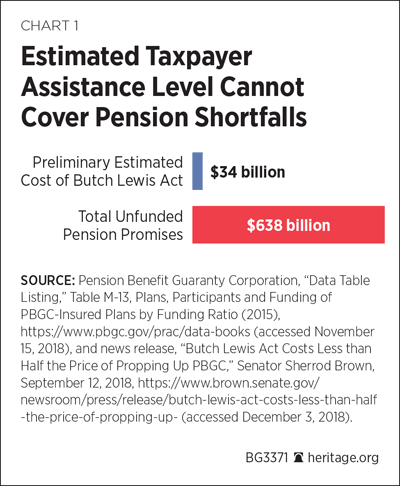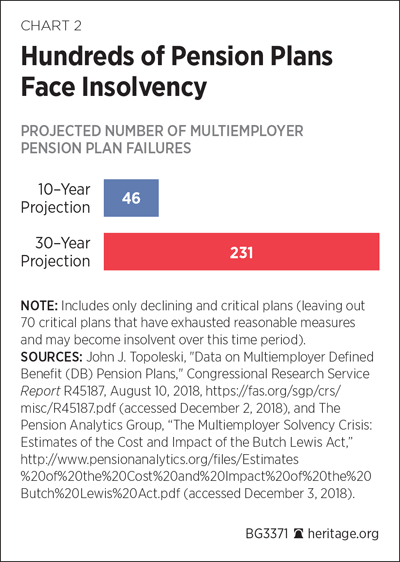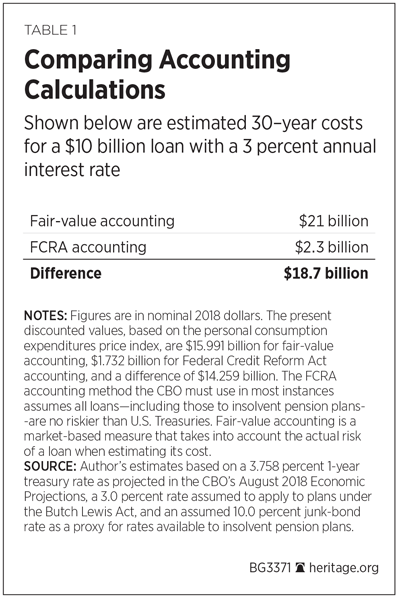Estimating the cost of federal loan programs is highly complex. The costs depend on how many people qualify for the loans, how many people choose to take them, how likely they are to repay them, and the accounting method used. In addition, the official score is a function of the time frame; the Congressional Budget Office (CBO) traditionally reports scores over a 10-year or 30-year period, but government loans often have costs outside the official budget score window.
Consequently, in the case of the CBO’s analysis of the Butch Lewis Act—a proposal to provide direct cash and subsidized loans to troubled multiemployer pensions—its estimates do not reflect the true costs of the proposal. Taking into account the legislation’s intent, the full time horizon of its costs, more accurate accounting measures, and the bill’s impact on pension plans’ future actions, the Butch Lewis Act would likely cost federal taxpayers hundreds of billions, or—very plausibly—more than half-a-trillion dollars.
The Butch Lewis Act
Introduced by Senator Sherrod Brown (D–OH), the Butch Lewis Act seeks to prevent all beneficiaries of multiemployer pensions from losing any portion of their promised benefits.REF To accomplish this, the act would create a new agency within the Treasury Department—the Pension Rehabilitation Administration (PRA)—to provide direct cash assistance to plans and subsidized loans to otherwise insolvent pension plans.
The way the process would work for troubled union pension plans is that they would have to prove their insolvency (their inability to make good on their pension promises), and the PRA would then grant them loans, direct cash assistance, or both. Plans needing direct cash (in order to reasonably repay a loan) would receive a lump sum and then a subsidized loan in addition to the cash. For the loans, pension plans would not have to repay any principal on the loan for 30 years. Although not specified, plans would likely pay an interest rate of only 3 percent or less. If plans cannot repay their loans when they come due, the bill specifies that plans could receive loan forgiveness or alternative repayment plans.
The Central State Teamsters multiemployer pension plan is an example. The plan has roughly $39 billion in unfunded pension promises and is on track to become insolvent in 2025.REF According to the Teamsters plan, the Butch Lewis Act would provide it with $20 billion to $25 billion in direct cash assistance, and $11 billion to $15 billion in loans.REF
With the cash and loans that the PRA provides, pension plans would be required to purchase more secure investments from the private sector to guarantee that their workers and retirees would receive their promised benefits. Plans would also need to use the funds to invest in the market, in hopes of generating high returns to repay the loans. By purchasing assets such as private annuities, recipients of multiemployer pension promises would gain ownership of 100 percent of their promised pension benefits while taxpayers would take on 100 percent of the liabilities. This would be great for workers and retirees with multiemployer pensions, while it would essentially empty the coffers of multiemployer pension plans and leave taxpayers with hardly a glimmer of hope that pension plans could repay their loans. In total, taxpayer liabilities could exceed the entire multiemployer pension system’s $638 billion-and-growing shortfall.
CBO Initial Estimates: Massively Underscoring Bill’s True Cost
In light of what the CBO called “highly uncertain” budgetary effects based on the Butch Lewis Act’s broad language, the CBO has not issued a formal score of the bill. It did, however, provide a preliminary analysis of a more than $100 billion cost from 2019 to 2028, but then noted in a later letter that “[u]nder some interpretations of the bill language, few plans would qualify for loans and assistance, resulting in federal costs that would be substantially less than $100 billion.”REF In a subsequent letter, the CBO apparently estimated a $34 billion cost over 10 years.REF For multiple reasons expressed below, this estimate does not reflect the bill’s true long-term costs.
A $34 Billion Bailout Cannot Solve a $638 Billion Shortfall. Proponents of the bill—including its sponsor Senator Brown—used the CBO’s revised $34 billion estimate to argue that the Butch Lewis Act would solve the multiemployer pension crisis and prevent benefit cuts at half the costREF of requiring taxpayers to shore up the Pension Benefit Guaranty Corporation (PBGC).REF This is almost certainly impossible (and it fails to acknowledge that taxpayers are explicitly not responsible for the PBGC’s deficit). Fully 96 percent of people with multiemployer pensions are in plans that are less than 60 percent funded, and the multiemployer pension system has promised $638 billion more in benefits than it set aside to pay.REF
The $34 billion CBO score assumes that few plans would receive loans and cash assistance. As noted by a Pension Analytics report on the cost and impact of the Butch Lewis Act, a “narrow interpretation [of the number of plans that would qualify for assistance] would render the BLA [Butch Lewis Act] entirely useless, because a loan program that originates only a small number of loans cannot possibly prevent the tidal wave of insolvencies that is quickly approaching.”REF
Considering that the bill intends to prevent any and all multiemployer pension cuts, along with the fact that it does nothing to require plans to increase their contributions, it should be obvious that $34 billion in taxpayer assistance cannot cover $638 billion in pension shortfalls. If the bill’s costs were actually that low, it would be—as noted by the CBO—because the bill would not prevent benefit cuts for many troubled plans. That is not the intent of the bill and it is not what its proponents say it does.
The Pension Analytics Group estimated that if the Butch Lewis Act instead provided loans to all 231 plans that are projected to become insolvent over the next 30 years, it would require more than $160 billion in immediate loans, and fully 52 percent of plans receiving loans would default on their loans within the first 30 years.REF

Even if the CBO scored a more generous interpretation of the Butch Lewis Act—one that, as described by its sponsors, prevents all benefit cuts—its score would still be only a fraction of the bill’s true long-term costs.REF That is because the CBO’s prescribed methodology for scoring bills includes a limited 10-year scoring window and non-market-based accounting, and it excludes significant macroeconomic incentive effects.
Limited Time Window. The CBO typically provides 10-year cost estimates, meaning it evaluates the Butch Lewis Act over the 2019–2028 period. While a significant number of multiemployer plans are expected to fail during that period, they are likely to fail around 2025, imposing costs in only three or four years of the next 10 years. The true costs of a plan thatREF fails in 2025 could span 80 years into the future.
The direct cash bailout component of the bill could have a significant impact in the 10-year window if plans receive single lump-sum payments. If they instead receive annual payments over multiple years, a significant portion of the costs would come outside the 10-year window. Moreover, because the bill specifies interest-only payments for 30 years, any potential loan losses will not come into play in a 10-year score, or even a 30-year score because the loans would take time to be dispersed and final repayment would be outside any scoring window that the CBO considers.
Additionally, the majority of plans that will fail will do so outside the 10-year window. While 1,158 multiemployer plans are less than 60 percent funded,REF the PBGC projects that only 46 are expected to fail within the next 10 years.REF Extending the time window to include the next 30 years, the Pension Analytics Group estimates that five times as many plans—231 in total—will fail.REF Thus, many plans that would receive assistance under the Butch Lewis Act would not receive it within the 10-year scoring window.

Inaccurate Accounting Method. Although the CBO believes that fair-value accounting provides a more accurate estimate of federal loan programs’ true costs, the Federal Credit Reform Act (FCRA) of 1990 requires the CBO to score federal loan proposals without regard to their real risk of default. FCRA accounting requires the CBO to assume that all loans are no riskier than U.S. Treasury bonds, which have virtually zero perceived default risk. The CBO explains the problem: “[E]ven though the government can fund its loans by issuing Treasury debt and thus does not seem to pay a price for market risk, taxpayers ultimately bear that risk.”REF
The alternative—market-based or fair-value accounting—takes into account the risk of a loan. A CBO report that compared the two accounting methods showed that three of its current loan programs will save the government $212 billion over the 2015–2024 period under FCRA accounting, but will cost taxpayers $120 billion under fair-value accounting—a difference of $332 billion just based on the type of scoring method.REF
For loans to multiemployer pension plans, the risks of default would be extremely high because, ironically, plans would have to prove their insolvency in order to receive a loan. According to the Pension Analytics Group, the default rate for loans under the Butch Lewis Act would be 52 percent, assuming that plans did not also receive cash transfers to help them repay the loans. To understand the high likelihood of default, one may consider the United Mineworkers of America’s (UMWA’s) pension plan. In 2016, the plan had only $31 million in contributions and $619 million in benefits (that is, $1 coming in for every $20 going out) and it is closed to new participants.REF Those finances make it virtually impossible that the UMWA’s plan, and many other troubled multiemployer pension plans, could repay a loan.
For loans to multiemployer pension plans, the risks of default would be extremely high because, ironically, plans would have to prove their insolvency in order to receive a loan.
Moreover, such plans could not qualify for loans from private banks, even less likely at a low interest rate. If such plans could receive loans, they would be at extremely high interest rates equal to or exceeding junk-bond rates of about 10 percent. Thus, the subsidy cost of government loans to pension plans would be extremely high. Take, for example, a $10 billion loan to a pension plan at a subsidized interest rate of 3 percent compared to a roughly 10 percent “junk bond” rate that the plan would likely have to pay if it could get a private loan. Over a 30-year period of interest-only payments, as specified in the Butch Lewis Act, the market-based subsidy cost of a $10 billion loan would be $21 billion, but FCRA scoring would count it as only $2.3 billion (the difference between the roughly 3.8 percent borrowing rate for the U.S. and the 3 percent subsidized rate charged to the plans).REF
Within just the 10-year scoring window, the fair-value subsidy costs would equal $7.0 billion, while the FCRA subsidy cost would be only $0.758 billion, implying that the bill would cost $6.2 billion less over the first 10 years than a more realistic estimate.REF As the CBO stated in a March 2012 report, “CBO’s view is that the cost of risk is a real cost to the government that is relevant for budgeting as well as for cost-benefit analyses.”REF Nevertheless, under FCRA accounting, these costs are hidden from the CBO’s official score.

Incentives for Further Deterioration. Bailouts create moral hazard. By shielding bad actors from the consequences of their poor choices and risky behavior, bailouts incentivize more of it. When the U.S. government stepped in to provide a de facto bailout through the Troubled Asset Relief Program (TARP), the result, according to a Federal Reserve study, was more risky behavior by banks receiving assistance.REF If multiemployer pension plans that have not set aside enough funds to make good on their promises can tap taxpayer funds, why would they not take more risk and continue promising benefits they cannot pay?
The Butch Lewis Act would effectively grant underfunded multiemployer pension plans a direct line to the U.S. Treasury, ensuring that workers with multiemployer pensions would receive 100 percent of any benefits promised to them—if not by their employers and unions who run their pension plans, then by taxpayers who had no role in private pensions. With insufficient rules governing the required contributions of multiemployer pension plans, and in particular, with provisions of the Multiemployer Pension Reform Act of 2014 largely waiving rules for poorly funded plans, there would be little to prevent plans from continuing to knowingly make pension promises they cannot keep.REF
Multiemployer pension plans’ unfunded pension promises increased by $42 billion in 2016 alone.REF Instead of employers reducing or eliminating the growth of unfunded liabilities by increasing contributions and shifting newer workers into defined contribution plans, employers would be encouraged to continue making promises they cannot keep. This could result in hundreds of billions of dollars in new unfunded—and taxpayer-backed under the Butch Lewis Act—multiemployer pension liabilities. The CBO’s score does not take into account changes in behavior that would almost certainly cause multiemployer pension plan funding to deteriorate even further and taxpayer costs to rise even higher.
A More Realistic Estimate of Long-Term Costs
The Butch Lewis Act makes clear its intent to stand behind 100 percent of promised multiemployer pension benefits, even reinstating benefits that have already been reduced. Thus, the bill’s long-term costs would far exceed the CBO’s initial $100 billion and $34 billion 10-year estimates. The costs could even exceed $638 billion, which represents the entire multiemployer system’s shortfalls.
The Butch Lewis Act would effectively grant underfunded multiemployer pension plans a direct line to the U.S. Treasury.
The Butch Lewis Act’s version of a pension bailout could exceed the entirety of the current funding shortfall for two reasons. First, the bill’s open-ended bailouts without funding requirement reforms would allow existing shortfalls to continue growing. (As mentioned above, multiemployer pensions added $42 billion in unfunded promises in 2016 alone.) Moreover, the loans to insolvent pension plans would subject tens—if not hundreds—of billions in taxpayer dollars to potentially risky investments. If those investments took a massive hit, not only would the loans not be repaid, but taxpayers would also still be on the hook for covering 100 percent of the plans’ unfunded pension promises.
Creating an open-ended and full bailout of the multiemployer pension system as proposed in the Butch Lewis Act would, in the long run, likely cost somewhere close to—and potentially exceed—the system’s current $638 billion in underfunding.REF While not a direct cost of the Butch Lewis Act, a private pension bailout would set a precedent for a bailout of public pensions plans with more than $6 trillion in unfunded pension promises.
Conclusion
The Butch Lewis Act would provide a means for multiemployer pension plans—of which there are about 1,400 covering 10.6 million workers and retirees—to receive taxpayer funds so that they can make good on an estimated $638 billion shortfall between the amounts they promised workers and the amounts they set aside to pay them. The CBO provided initial estimated scores of the Butch Lewis Act, ranging from $34 billion to upwards of $100 billion over 10 years. However, those estimates massively understate the true costs of the Butch Lewis Act.
The open-ended bailouts contained in the Butch Lewis Act make it the poster child for moral hazard.
For starters, the lower $34 billion estimate assumes that few plans actually qualify for assistance, but the bill’s intent is to prevent $638 billion worth of broken pension promises. Also, the multiemployer pension system’s broken promises span up to eight decades into the future, meaning that a 10-year cost estimate captures only a small fraction of the bill’s costs. Moreover, although the CBO does not believe that the accounting method it is required to use when scoring most federal loan proposals, such as the Butch Lewis Act, accurately reflects the true costs, it nevertheless has to ignore the risk exposure placed on taxpayers from these potential loans. Finally, the open-ended bailouts contained in the Butch Lewis Act make it the poster child for moral hazard. By shifting the consequences of reckless behavior by managers of union pension plans to innocent taxpayers, the Butch Lewis Act would encourage more underfunding, leading to ongoing and growing taxpayer costs.
Taking into account the full view of the Butch Lewis Act, its costs would likely be many multiples of what the CBO initially estimated. Instead of as little as $34 billion or upwards of $100 billion as initially estimated, the Butch Lewis Act would likely cost taxpayers hundreds of billions and potentially even more than the entirety of the multiemployer system’s $638 billion deficit.
Cost estimates of bills should be as accurate as possible so that policymakers can make informed decisions. When evaluating long-term loan proposals, such as the Butch Lewis Act, the CBO should provide long-term scores, apply market-based fair-value accounting methods, and, to the extent possible, consider the behavioral effects of such proposals. Without a formal score from the CBO that includes these provisions, policymakers should view the initial CBO scores of the Butch Lewis Act with a grain of salt, noting that they account for a very limited portion of the bill’s likely long-term costs.
—Rachel Greszler is Research Fellow in Economics, Budget, and Entitlements in the Grover M. Hermann Center for the Federal Budget, of the Institute for Economic Freedom, at The Heritage Foundation.

